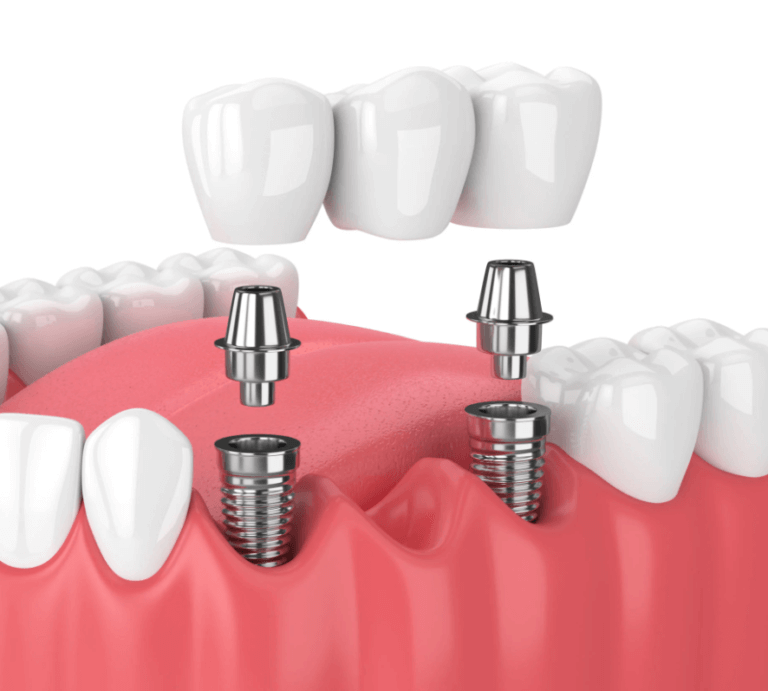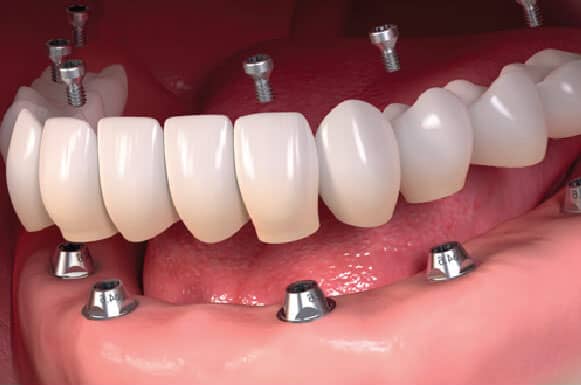Fallen Out Dental Implant Bridge

What Is A Fallen Out Dental Implant Bridge?
A dental implant bridge is a permanent prosthetic designed to replace multiple missing teeth. It involves one or more dental implants, which are small titanium posts surgically placed into the jawbone. The implants support a custom bridge that mimics the look and function of natural teeth, allowing for normal chewing, speaking, and restoring your smile. While dental implant bridges are durable and long-lasting, they can occasionally become loose or fall out.
Losing a dental implant bridge can be alarming, especially if you rely on it for daily oral function and appearance. Before you contact a Toronto dentist to examine A Fallen Out Dental Implant Bridge, there are some things you should know as a patient:
- Why Did My Dental Implant Bridge Fall Out?
- Signs And Symptoms Of A Dental Implant Bridge Falling Out
- Treatment Options For A Fallen Out Dental Implant Bridge
- Managing A Fallen Out Dental Implant Bridge Until You Can See The Dentist
- Frequently Asked Questions About Dental Implant Bridges
If you have questions about A Fallen Out Dental Implant Bridge or other dental problems, please contact us for more information.
Why Did My Dental Implant Bridge Fall Out?
Understanding the potential reasons why an implant bridge falls out can help determine the best course of action. Common causes include:
- Loose Screw: The screw that attaches the bridge to the implant post can loosen over time, especially if insufficient torque was applied during placement.
- Prosthetic Misfit: An improperly fitting bridge may not securely attach to the implant, leading to instability.
- Failed Osseointegration: The failure of the implant to bond with the jawbone can cause the implant to become loose. This may result from poor bone health, smoking, or inadequate oral hygiene.
- Trauma or Injury: Accidents, such as sports injuries or falls, can cause a dental implant bridge to become dislodged.
- Peri-implantitis: This is an infection around the implant that can lead to bone loss and eventual bridge detachment.
It’s essential to contact a qualified dental professional to assess the cause and recommend appropriate treatment. If you have further questions about A Fallen Out Dental Implant Bridge, please contact us.
Signs And Symptoms Of A Dental Implant Bridge Falling Out
Knowing the symptoms of a loose or fallen implant bridge can help you seek timely treatment. Look for these signs:
- Visible Gap: A noticeable gap in your smile where the bridge once was.
- Loose Bridge: The bridge may feel wobbly or move when touched.
- Pain or Discomfort: Sensitivity or discomfort, especially when chewing.
- Changes in Bite Alignment: You may notice difficulty chewing or a change in your bite alignment.
- Swelling or Redness: Inflammation around the implant site could signal infection.
If you experience any of these symptoms, seek dental care as soon as possible to prevent complications. If you have further questions about signs or symptoms of A Fallen Out Dental Implant Bridge, please contact us.

Treatment Options For A Fallen Out Dental Implant Bridge
Treatment for a fallen-out dental implant bridge depends on the cause and condition of both the bridge and implant. Here are some common options:
- Reattaching the Bridge: If the bridge is intact and the implant is stable, your dentist may be able to clean and reattach the bridge.
- Bridge Replacement: If the bridge is damaged, your dentist can create a new, custom bridge to fit securely on the implants.
- Implant Replacement: If the implant itself is loose or damaged, replacing the implant may be necessary. This may involve bone grafting if bone loss has occurred.
Your dentist will help determine the best course of action based on your individual needs. If you have further questions about treatment options for A Fallen Out Dental Implant Bridge, please contact us.
Managing A Fallen Out Dental Implant Bridge Until You Can See The Dentist
If your implant bridge falls out and you’re unable to visit a dentist immediately, here are some tips to manage the situation:
- Keep the Bridge Safe: Place the bridge in a clean container to avoid loss or damage. Bring it with you to your dental appointment.
- Maintain Oral Hygiene: Gently brush around the exposed implant site and consider rinsing with a warm saltwater solution to reduce inflammation.
- Avoid Chewing on the Affected Side: Stick to soft foods and avoid chewing on the side where the bridge fell out.
- Consider Over-the-Counter Pain Relief: If you’re experiencing discomfort, taking ibuprofen or acetaminophen as directed can help manage the pain.
It’s important to see your dentist as soon as possible to receive professional treatment for a fallen out dental implant bridge. In the meantime, these tips can help manage the situation and minimize discomfort. If you have further questions about managing A Fallen Out Dental Implant Bridge, please contact us.
Frequently Asked Questions About Dental Implant Bridges
- How long do dental implant bridges typically last?
Dental implant bridges can last 15-20 years or more with good care and regular checkups.
- What happens if I ignore a fallen-out dental implant bridge?
Ignoring a detached implant bridge can lead to complications such as infection, bone loss, and further implant instability. It’s best to see your dentist as soon as possible.
- Can a dental implant bridge be repaired if it falls out?
In many cases, a fallen-out bridge can be reattached if the bridge and implant are in good condition. However, if there’s significant damage, replacement may be necessary.
- Can I reattach the bridge myself?
It’s not advisable to attempt reattaching the bridge yourself, as improper placement can cause further damage. Seek professional dental assistance.
If you’re dealing with a loose or fallen-out dental implant bridge, contact us for prompt, professional care. We offer assessments and treatment options to help restore your dental function and protect your smile.

